Caffeine is a stimulant that is naturally made, and it can be found commonly in tea, coffee, and cacao plants. These days, you can find caffeine in soda and other beverages as well. Despites that coffee is one of the main sources of caffeine that you can look for among other mentioned beverages. Not to mention other caffeinated beverages including tea, chocolate, and soda, coffee is the world’s most favorite beverage to boost energy and metabolism. Do you know how much caffeine you have consumed drinking coffee? The amount of caffeine varies differently depending on various conditions such as types of drink and production. This chemical substance can be found in food as well. This article will provide you information on what caffeine is, the source of caffeine varied by types of coffee, drink types, and other related conditions. Additionally, there will be a discussion on recommended caffeine intake as well.
Contents
What is Caffeine?
Before we get to see different caffeine content, we should know what caffeine is first. Caffeine is a natural stimulant which can be found in coffee. This stimulant works by stimulating the central nervous system of the brain, helping you stay alert and awake. According to Healthline, caffeinated soft drinks hit the market in the late 1800s. Nowadays, around 80% of the world population consumes caffeinated products daily. In the US, 90% of Americans consume caffeine in a variety of forms every day.
The Advantages of Caffeine
Caffeine stimulates the brain by blocking adenosine, which is a neurotransmitter, to keep you alert and stay awake. Caffeine has a lot of health benefits, such as improving your mood and brain function. Because caffeine blocks the brain-signaling molecule adenosine, it increases dopamine and norepinephrine, which are other signaling molecules. Moreover, caffeine can boost metabolism and fat burning. However, this method can only show effects if you plan to have a long-term diet plan. Furthermore, caffeine intake enhances exercise performance because it can help the glucose stored for the long term, improve muscle contractions, and increases tolerance to fatigue.
In terms of more critical health benefits, coffee helps protect against heart disease and type 2 diabetes. Yet this may apply to individual conditions. Besides, coffee helps with liver protection, longevity, decreases cancer risk, skin protection, gout prevention, and gut health. These benefits can be obtained only if you have moderate consumption as well. Excessive drinking may lead to other negative impacts and side effects on your health.

Caffeine Amount According To Coffee Types
This energy-boosting stimulant can be found comprising different amounts depending on the types of coffee. Caffeine amounts can be varied from one type to another, and below are the typical type of coffee people often drink.
Brewed Coffee
If you are a coffee drinker, you perhaps have heard about brewed coffee. Brewed coffee is a type that can be called filter coffee. The process of making brew coffee includes brewing ground coffee in hot water, but there are many ways to make brewed coffee as well. Some of which involves using a filter, a percolator (a type of coffee brewing pot used to brew coffee by cycling the boiling through the coffee ground), or a French press (Illustrated in the picture below). For brewed coffee, it typically contains around 95mg of caffeine in an 8-oz cup.
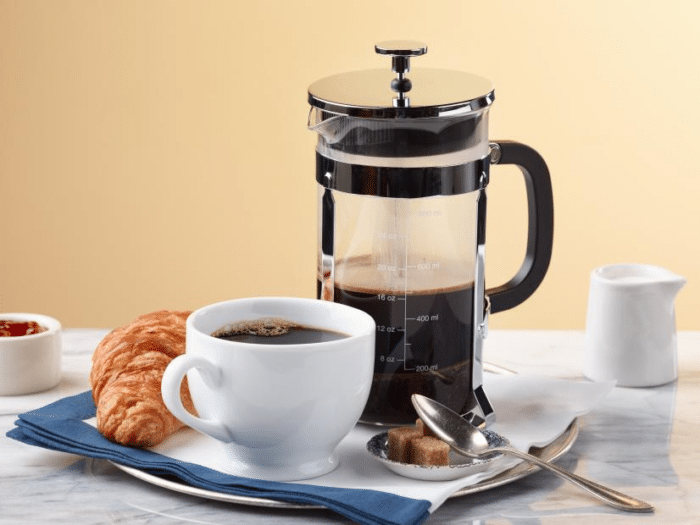
Decaf Brewed
Decaf coffee is literally referring to coffee without caffeine, or caffeine has been extracted. Is there no caffeine in it? Well, decaffeinated coffee does not mean there is zero caffeine in it, but a sizable amount of caffeine has been separated or removed from the roasted beans. Despite decaffeination, there is still some caffeine. Typically, an average 8-oz cup of decaf coffee contains around 2mg of caffeine. Therefore, you can somehow decrease your caffeine intake with this type.
Cold Brew
After reading about brewed and decaf brewed coffee, cold brew is the next target. Cold brew is made chilled because it is made in not a high-temperature concentration. This type is different from iced coffee, and it involves steeping coffee grounds in water at room temperature between 8 and 24 hours. This type has less caffeine content too. An average of 12-oz of cold brew contains between 153mg and 238mg of caffeine.
Instant Coffee
Instant coffee becomes popular for quite a long time, and it are mostly consumed by those who do not have time to grab themselves a coffee at the coffee shop. It is compact and easy to make. With pocket-size packaging and convenience, instant coffee are mostly put in the working space like office or meeting room where people can spend a few minutes making them. Compared to other types of coffee, instant coffee has less caffeine in its coffee powder. A regular 8-oz cup of instant coffee contains approximately 62mg of caffeine.
Espresso
Espresso is another coffee-brewing method with less water to make. Do you sometimes wonder why they serve espresso in such a small cup? This is due to the high amount of caffeine in espresso. It is a concentrated form of coffee beverage that is enormously served in only little shots. Espresso contains more caffeine than any other caffeinated drink. There is 63mg of caffeine in only a 1-oz shot of espresso.
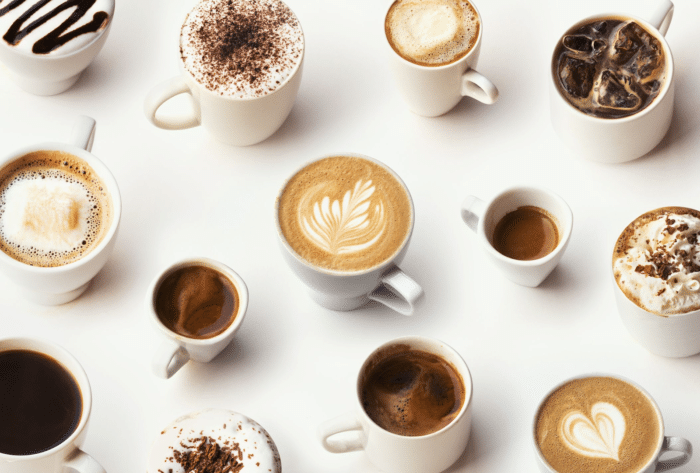
Different Brand Also Has Varying Amount of Caffeine
The type of coffee affects the caffeine content, yet different coffee brands provide varying caffeine range as well. There are many chain eateries and roasting companies globally, and they sometimes offer different varieties from each other. For example, Starbucks’s decaf coffee contains 20mg of caffeine, while Dunkin’ Donuts contains only 10mg. However, Starbucks’s cold brew contains only 155mg. Meanwhile, Dunkin’ Donuts includes 260mg of caffeine.
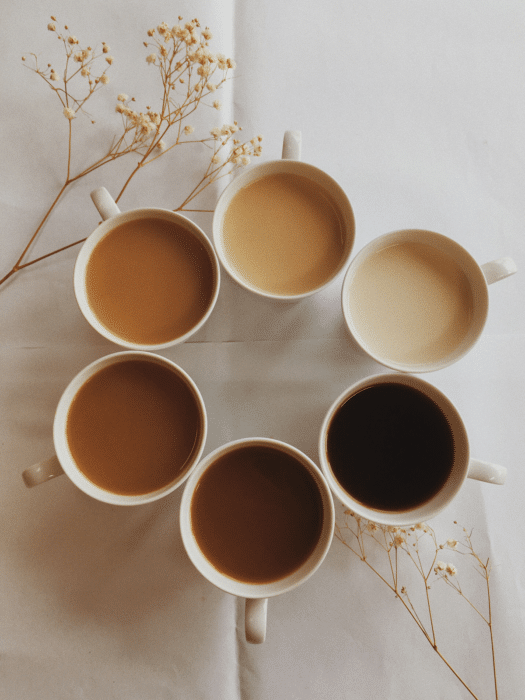
Several Factors That Affect The Caffeine Content in A Cup of Coffee
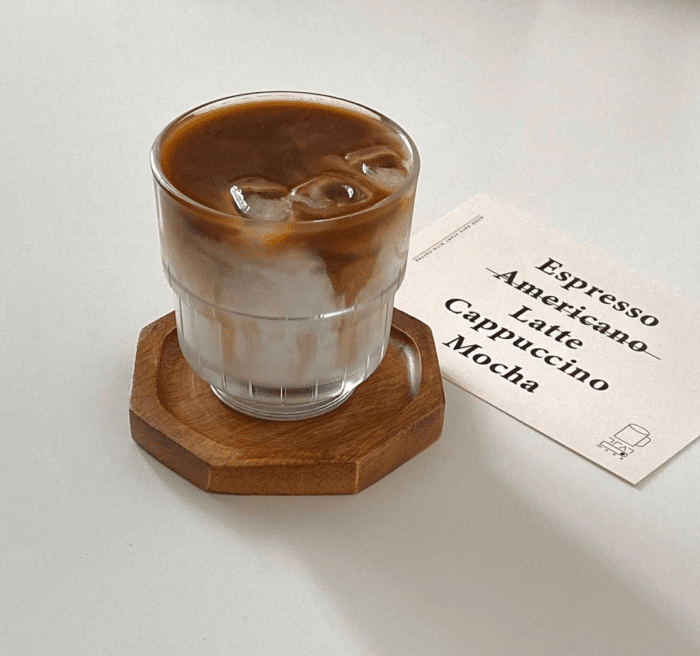
First, one of the significant factors affecting caffeine content in a coffee cup is the bean type. There are plenty of species and plants. Therefore, coffee beans from different plants have varying caffeine content as well. According to Medical News Today, there are 2 top widespread species types of coffee beans: (1) Coffea arabica, known as Arabica, and (2) Coffea canephora, which is known as Robusta. Robusta type contains twice as much as the caffeine amount of caffeine in Arabica. For instance, 1kg of dry roasted Robusta contains between 68.6mg-81.6mg of caffeine. However, 1kg of Arabica contains 34.1mg-38.5mg of caffeine.
Besides the type of coffee beans, several other factors affect the caffeine content, such as the roasting type, the brewing method mentioned above, the amount of ground coffee used while brewing coffee, and the serving size. There are light roasts for the roasting type (have light body and a bit acid), a medium roast (medium brown colour), a medium-dark roast, and a dark roast. Moreover, the amount of ground coffee used in the making process affects the caffeine content in the beverage too. For example, typically, we use two tablespoons of ground coffee for six ounces of water, but we can always change for more flavour and a heavier caffeine concentration. Furthermore, the serving size as well tells us about how much caffeine in the coffee. For instance, espresso is usually served in a small cup for one shot of espresso because the caffeine amount is already high.
Other Sources of Caffeine: Aside From Coffee, Where Can We Find Caffeine?
There are many other sources of caffeine you can find in beverages and food. Sometimes you may not notice the intake of food and drink you consume daily that might as well have caffeine in them. These are a few common types we consume and their caffeine content:
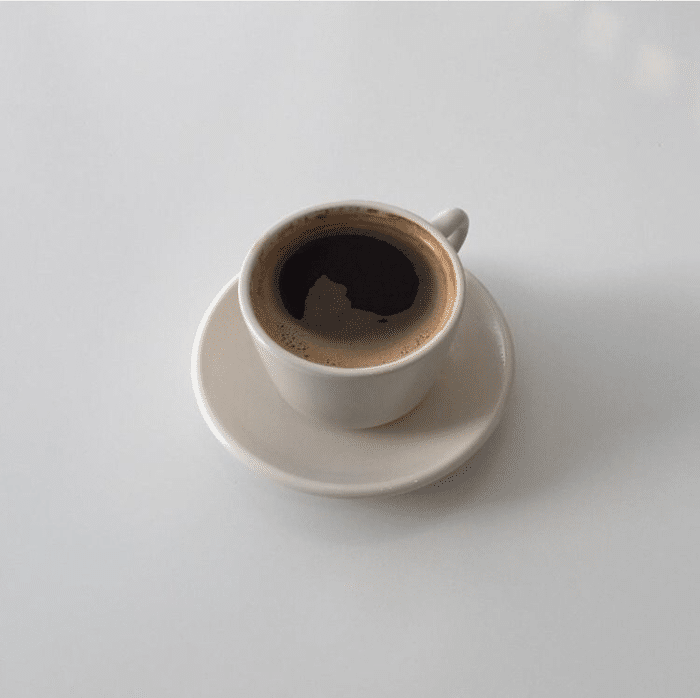
Tea
Some people might not notice that there is caffeine in tea, yet there is less caffeine than regular coffee. The caffeine content varies according to the species as well. For an 8-oz cup of green tea, there is around 28mg of caffeine. Meanwhile, there are 47mg of black tea. Despite that, tea is a pleasant alternative for those who want to cut off coffee consumption.
Chocolate
Chocolate comes from cacao plants, and it is undoubtedly a noticeable amount of caffeine in it. However, the amount varies from type to type as well. For example, darker chocolate has higher caffeine content than the lighter one, which mixes with milk. The more milk is added the less caffeine content.
Soda or Soft Drinks
Coke or other fruit-flavoured soda that we drink sometimes contains caffeine. We might not have the taste of caffeine due to the high sugar amount in these sodas. However, there are caffeine used in the ingredients. The caffeine content is meant to help to boost your energy. There is about 33mg of caffeine in a regular 12-oz can of soft drink.
Energy Drinks
Same to soda and soft drinks, energy drink also contains caffeine in it. There is a higher amount of caffeine and sugar in energy drinks, but they can be natural or synthetic. The increased amount of caffeine used to help with energy-boosting and stay productive. In an average 8-oz can, the caffeine content can range from 40-250mg.
Medications
Caffeine in medicine is common for pain relief. Caffeine is a stimulant in the central nervous system, and it has been used in many drugs. It is most consumes to treat migraine headaches and as a psychoactive drug. It is also used to treat tiredness and drowsiness.
Side Effects of Caffeine
Coffee is generally safe and can provide you with several health benefits discussed in the previous section. Despite the benefits, excessive coffee intake can cause several risks and side effects as well.
First of all, if you consume up to 4 cups of coffee per day, you may encounter these problems such as headache like migraine, high blood pressure in some individual, causes insomnia, nervousness, irritability, frequent urination or inability to control your urination, your heart beats fast, and, of course, you feel like your body shakes called muscle tremors.
Secondly, people who do not consume coffee often are prone to its side effects, especially people who are sensitive to coffee. Even a little of it can make you jittery; your sensitivity to coffee depends on how much you are used to drinking. Caffeine might have interaction with particular or specific medication as well that requires a doctor’s consultation.
Thirdly, coffee can interfere with your sleep rhythm as well. Because it interrupts your sleep at night time, causing you trouble sleeping and making you feel fatigued during the day, this continues to interrupt your daytime alertness and productivity. Then the cycle will go on. You may consider the time to drink your coffee and a suitable amount of coffee intake to resolve this.
Recommended Amount For Caffeine Intake
Many people rely on coffee in their daily life from morning to evening to maintain their concentration. If you are one of them, consider the sufficient amount of coffee to prevent overconsumption because it might adversely affect your health. Coffee offers many health benefits unless you moderately and adequately consume it.
For daily intake, according to the U.S. Department of Agriculture (USDA) and the European Food Safety Authority (EFSA), it is recommended to consume up to 400mg, which is a safe amount of intake for most healthy adults. You should be aware that coffee provides many health benefits for adults, but it is not suitable for children. Moreover, adolescents and young adults should be cautious about the excessive amount of caffeine as well. Furthermore, it is suggested for pregnant women and women who breastfeed their baby to cut down caffeine intake to under 200mg per day. Specifically, those who are sensitive to caffeine should curb their coffee routine.
Though the study shows several health benefits of coffee for adults, there are also many side effects caused by caffeine intake.
References
- Caffeine content of different types of coffee | Medical News Today
- Caffeine: How much is too much | Mayo Clinic Staff | Mayo Clinic
- What is caffeine, is it good for health? | Alina Petre | Healthline
- Caffeine chart | Center for Science in the Public Interest
- How much caffeine is in a cup of coffee? | Roasty coffee
